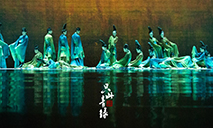Treasures on the road: Recalling a touring exhibit of Afghanistan’s relics in China

Timeline of the touring exhibit of Afghanistan's relics in China. (People's Daily Online/ Zhong Wenxing)
Nine kilometers southwest of the center of Kabul stands a two-story building – the National Museum of Afghanistan – where a stunning collection spanning millenniums of history can be found. After 40-plus years of instability and bitter conflict, the ancient artifacts still rest quietly within, having survived a coup d’état, invasions, and intermittent lootings, forming an ineffable silence so loud that it has made the whole world fretful about their situation.
Now that Afghanistan has become a news frequenter, Chinese netizens started a round of cyber recollection of a travelling exhibit. In March 2017, a bevy of Afghan treasures made a big splash at the Palace Museum in Beijing. In the ensuing three years, they went on to be exhibited to throngs of people in nine Chinese cities, from Dunhuang to Nanjing, and from Zhengzhou to Hong Kong. Well-designed exhibitions offered museumgoers both tangible evidence of the richness of Afghan culture and compelling stories of contemporary Afghans who had safeguarded these treasures for the entire world to see.
History will never be lost
Displayed by the 231 priceless items is a vivid picture of Afghanistan from the 3rd century BCE to the 1st century CE, the most vibrant period in the nation's history. Among the selected objects were golden goblets from the Bronze Age site of Tepe Fullol; architectural elements and statues from the Hellenistic city of A? Khanum; Indian-styled ivories, Roman glassware and other goods traded along the Silk Road in the Begram treasure trove; and turquoise-encrusted gold jewelry from the necropolis of Tillya Tepe. These four storied archeological sites reveal an impossibly rich mosaic of cultures and how stylistic and intellectual influences intermingled at this important crossroads of the ancient Silk Road.
Somehow, these glimmering artifacts are constantly enveloped by a tinge of sorrow, reinforced by all the efforts made to save them. In the 1980s, employees of the National Museum in Kabul realized the risk to the relics and hid away part of the museum's holdings in a secure bank vault. For decades, those hidden artifacts were referred to as 'lost' treasures. Rumors are that the objects had been melted down, changed hands on the black market or wrested away to Moscow. The secret was kept among five courageous Afghans, and it was not until 2003 when they finally got the chance to reveal them in orderly fashion to the world.
The heroic rescue of the heritage also reminded people of another harrowing journey during the Chinese People's War of Resistance against Japanese Aggression, when a group of unsung heroes spent a lengthy decade, risking their lives, to evacuate 13,427 crates and 64 bags of artifacts from the Palace Museum to the southern part of the country. During that turbulent wartime period, China also sent some 700 antiquities to the United Kingdom for an unprecedented international exhibition at the Burlington House of the Royal Academy of Arts. The exhibition led to a boom in studies on Chinese art, literature and history, and was definitely one of the defining moments in the shift in foreign attitudes towards China and the Chinese, something much-needed for the then China. A nation stays alive when its culture stays alive, as motto engraved at the entrance of the National Museum of Afghanistan says, is a lesson that the Chinese people know just all too well.
Future-making
Recent chaos in Afghanistan caused huge concern about these treasures. The last worldwide outcry of a similar kind was twenty years ago, after the demolition of the soaring Buddha of Bamiyan. Since then, the international community has beefed up efforts to reconstruct the Buddha and preserve other Afghan treasures. A Chinese couple and their team also used projection technology to 'rebuild' the statue into the cliff-side alcoves. That was the first 3D reincarnation of the Bamiyan Buddha.
Moreover, with the foresight of protecting cultural heritage for future generations, Afghans started to cooperate with international organizations and research institutions for documentation, mitigation and capacity building, having launched temporary exhibitions around the world to display their national identity and promote cultural exchanges. The ones that took place in China were also part of such efforts. Before coming to China, these treasures had already traveled to 10 countries, including Italy, the United States, and Japan. These exhibitions have freed us from the image of a war-ravaged Afghanistan and have shown us how two ancient civilizations could find a deeper understanding by delving into each other's past.
Concerned, Chinese netizens uploaded their photos taken during the exhibitions to cherish their short encounter with the treasures and commented on related Weibo posts: "Instead of a touring exhibit, it's more like a rally race among the international community to protect the heritage. I hope these treasures are safe and well." "These are the treasures of all humanity and must be well protected." "It's their past, and it's their future. I believe that these Afghan treasures will have a happy ending."
Needless to say, the country is still chaotic and the fate of the remarkable legacies in Afghanistan still face uncertainties. Yet these joint exhibitions, understood in the broadest sense, could be a reminder, a reminder of the past and universal values. A few weeks ago, Taliban officials promised to protect the National Museum of Afghanistan and posted a group of armed guards outside the museum. What will the future hold? The whole world is now in a wait-and-see mode.
Photos
 Dance show saluting traditional culture of the Song Dynasty makes its debut
Dance show saluting traditional culture of the Song Dynasty makes its debut Village in SW China’s Yunnan embraces prosperity through agricultural tourism
Village in SW China’s Yunnan embraces prosperity through agricultural tourism Eighth birthday for pair of giant pandas celebrated in Haikou, Hainan province
Eighth birthday for pair of giant pandas celebrated in Haikou, Hainan province Olympic gold medalists portrayed in Shanxi artist’s polymer clay sculptures
Olympic gold medalists portrayed in Shanxi artist’s polymer clay sculptures
Related Stories
- Afghanistan shows deficiency in EU's strategic autonomy comes with price: top diplomat
- China urges investigation of massacre of Afghans by U.S.
- Commentary: Washington's hubris tumbles in epic Afghanistan fiasco
- Henan Museum reopens after 30 days of closure
- British foreign secretary rejects U.S. blame for indirect role in Kabul terror attack
Copyright © 2021 People's Daily Online. All Rights Reserved.






